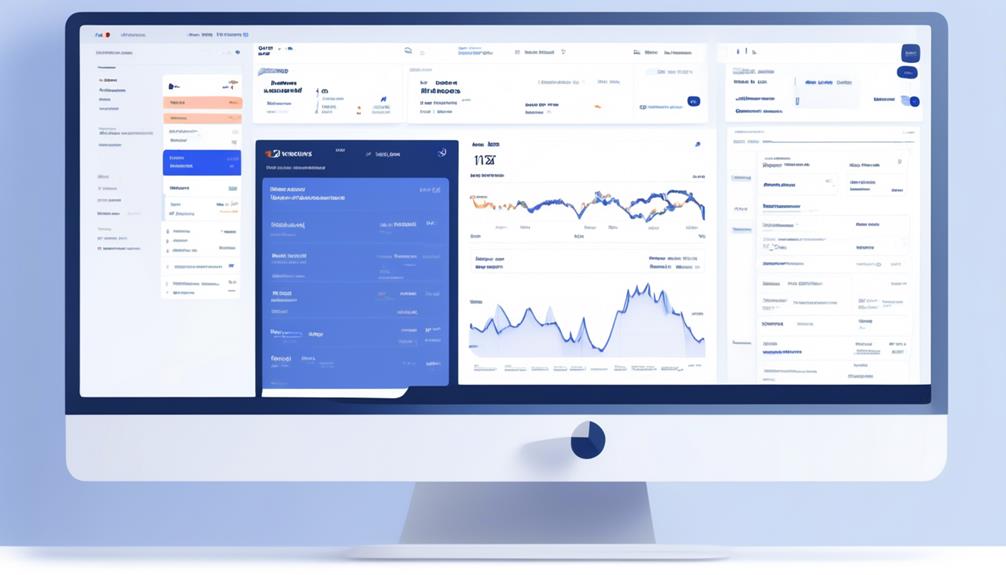Expanding email automation is like tending to a garden full of potential. Just as a gardener carefully tends to each plant for its growth, businesses must nurture their email automation strategies to engage and captivate a growing audience.
However, the challenge lies in maintaining that personalized touch while managing a larger volume of contacts and campaigns.
I'll share practical insights and proven strategies for navigating this complex landscape, ensuring that your email automation efforts not only keep pace with your business growth but also foster meaningful connections with your audience.
Key Takeaways
- Email automation saves time and ensures targeted and personalized communication with customers.
- By creating automated workflows based on customer behavior, engagement and conversions can be enhanced.
- Email automation complements human interaction and enhances relationships with the audience.
- Leveraging advanced automation tools can enhance efficiency, accuracy, scalability, and analytics in email marketing efforts.
Understanding Email Automation
In today's digital marketing landscape, understanding email automation is crucial for streamlining processes and maximizing the efficiency of email marketing efforts. Email automation involves using software to execute email marketing tasks without manual intervention, saving time and ensuring targeted and personalized communication with customers.
By leveraging email automation tools, marketing teams can create automated workflows that send tailored emails based on customer behavior, leading to enhanced engagement and conversions. This strategic approach allows for the seamless execution of various campaigns, such as sending welcome emails to new subscribers or reminding customers about abandoned shopping carts.
Understanding email automation is pivotal in aligning marketing goals with scalable solutions. It enables the delivery of relevant and timely content, contributing to a more effective and efficient email marketing strategy.
Benefits of Email Automation

Implementing email automation yields numerous benefits, including saving time and energy by automating repetitive tasks and eliminating manual errors. By leveraging email automation, you can scale your email marketing efforts and achieve your marketing goals more efficiently. The table below outlines the key benefits of email automation, highlighting its impact on scaling your email and customer engagement.
| Benefits of Email Automation | Description |
|---|---|
| Saves Time and Energy | Automating repetitive tasks and eliminating manual errors. |
| Builds Trust and Rapport | Sending timely and valuable content to contacts. |
| Increases Conversion and Retention Rates | Nudging contacts to take the next steps in the sales cycle. |
| Complements Human Interaction | Enhancing relationships with the audience. |
Email automation not only streamlines communication and follow-up processes in direct sales but also enhances customer engagement, ultimately contributing to the growth and scalability of your email marketing efforts. It is a strategic tool that aligns with the analytical approach needed to master the art of scaling your email and achieving your marketing goals.
Email Automation Strategies
Leveraging clear criteria to define the target audience, we can strategically deploy email automation workflows for personalized and effective customer engagement. By utilizing email automation tools, we can send personalized communications that cater to specific customer actions and behaviors. Implementing automation workflows enables us to optimize email marketing campaigns by delivering timely and relevant content to the right audience segments. This approach allows us to scale our email marketing efforts while maintaining a high level of personalization and relevance.
One of the key strategies for effective email automation is to create targeted workflows for different customer segments. By analyzing customer data and behavior, we can design automation workflows that cater to specific customer journeys and preferences. This targeted approach ensures that our emails are more relevant and engaging, leading to higher open and click-through rates.
Furthermore, leveraging behavior-based triggers allows us to automate follow-ups and efficiently manage a large number of contacts. This not only saves time and resources but also ensures that we're engaging with our audience at the right moments.
Ultimately, by implementing these strategies, we can optimize our email marketing efforts and achieve better results in terms of customer engagement and conversion rates.
Personalization in Email Automation

To seamlessly advance our discussion from email automation strategies, we'll now focus on the pivotal role of personalization in enhancing the effectiveness of our email automation workflows.
Personalization is crucial in scaling email automation as it allows us to create tailored and relevant messages for individual customers. By leveraging customer data and analytics tools, we can implement personalization to send targeted communications to different segments of our audience. This not only improves customer experience but also increases engagement and conversion rates.
Here are a few strategies to effectively implement personalization in email automation:
- Use personalization codes or widgets to embed personalized content in automated emails.
- Tailor messages based on individual customer behavior and interactions with the brand to enhance relevance and effectiveness.
- Implement A/B testing to optimize the personalization strategies and ensure the highest impact on customer engagement.
Leveraging Advanced Automation Tools
We must recognize the significant benefits of leveraging advanced automation tools in our email marketing efforts.
The right automation tools can enhance efficiency, accuracy, and scalability, allowing us to effectively manage a large volume of contacts and streamline our email campaigns.
Additionally, strategic tool selection and implementation tips are crucial for maximizing the potential of advanced automation features.
Advanced Automation Benefits
Utilizing advanced automation tools in email marketing offers significant benefits. These include advanced personalization capabilities, improved targeting, scalability, and enhanced analytics. Collectively, these contribute to a more effective and efficient marketing strategy.
When leveraging advanced automation tools, you can:
- Tailor emails based on individual customer behavior, interests, and previous interactions with the brand. This results in higher engagement and conversion rates.
- Enable more targeted and relevant messaging to different segments of the audience. This leads to improved customer satisfaction and loyalty.
- Scale campaigns and expand reach. Automation workflows are scalable and can be applied to all customers who fit the designated criteria. Ultimately, this drives business growth.
Automation Tool Selection
When selecting advanced automation tools for email marketing, it's crucial to carefully consider the features and functionality that align with the specific needs and goals of your marketing strategy.
Look for email marketing software that offers comprehensive A/B testing, robust analytics, and the ability to create dynamic content.
Integration with other marketing tools and platforms is also essential for seamless operations.
Furthermore, consider the effectiveness of drip campaigns in nurturing leads and engaging customers. Prioritize tools that provide easy-to-use drag-and-drop email builders and reliable customer support.
Additionally, ensure that the selected automation tool offers scalability, security, and compatibility with your existing systems.
Automation Implementation Tips
Transitioning from the careful selection of advanced automation tools for email marketing, we now focus on leveraging these tools to implement effective automation strategies that enhance customer engagement and drive campaign performance.
Utilize Personalization: Leverage advanced automation tools to create personalized and targeted campaigns based on customer behavior, interests, and previous interactions with the brand.
Implement Tailored Workflows: Use automation workflows to send tailored emails such as welcome messages to new subscribers, reminders for abandoned carts, and post-purchase cross-sell and upsell emails.
Integrate Twilio Engage: Integrate Twilio Engage for personalized and data-driven email marketing campaigns, audience segmentation, and omnichannel engagement leveraging over 400 out-of-the-box integrations.
Segmentation for Email Automation

When it comes to email automation, segmenting your audience allows for more personalized and targeted communication. By tailoring content and offers to specific segments, we can increase relevance and engagement.
Using behavioral triggers for segmentation can further enhance the effectiveness of our email automation efforts.
Targeted Audience Segments
Utilizing targeted audience segments through segmentation for email automation allows for the delivery of personalized and relevant content based on specific criteria, improving engagement and conversions.
When it comes to targeted audience segments, consider the following:
- Enhanced Personalization: Segmenting your audience enables tailored content based on demographics, behavior, and engagement, leading to higher engagement and click-through rates.
- Improved Conversion Rates: By delivering the right content to the right audience at the right time, segmentation for email automation can significantly boost conversion rates.
- Strategic Lead Generation: Effective segmentation allows marketing teams to use sales prospecting tools to create personalized customer journeys, adding value and relevance to each interaction for successful lead generation efforts.
Personalized Content Delivery
To optimize email engagement and conversions, segmenting your email list based on relevant criteria is essential for delivering personalized content to distinct groups of recipients. By leveraging user-based segmentation in email automation, you can tailor content to individual preferences and behaviors. This allows for targeted product recommendations, comprehensive lead nurturing, and increased relevance in your email communications.
Dynamic emails, driven by segmentation and personalization, enable you to deliver highly tailored content that resonates with each recipient. Implementing dynamic content and behavior-based triggers ensures that your automated campaigns are timely and relevant, leading to higher engagement and conversion rates.
Continuously monitoring and optimizing your email automation strategy based on data and feedback will further enhance the effectiveness of your personalized content delivery.
Behavioral Triggers for Segmentation
Implementing behavioral triggers for segmentation in email automation enhances the precision and relevance of targeted communication to specific customer segments. This strategic approach allows for personalized messaging based on user preferences and interactions, ultimately improving the conversion rate and engagement with the targeted audience.
Leveraging behavioral triggers for segmentation enables the delivery of tailored content, ensuring that the right message reaches the right audience at the right time. By utilizing A/B testing and analyzing customer behavior, marketers can refine their segmentation strategies to deliver more effective and impactful email automation campaigns.
This level of precision in segmentation not only increases the efficiency of email automation but also fosters stronger connections with customers by providing them with content that aligns closely with their interests and actions.
Implementing Abandoned Cart Emails

Regularly sending abandoned cart emails is a key strategy to recover potential sales and prompt customers to complete their purchases. Implementing abandoned cart emails through email automation is crucial in aligning follow-up efforts with the customer journey.
By setting up automated triggers, businesses can send timely and personalized abandoned cart emails to remind customers of items left behind and encourage them to return and complete their purchases. These email campaigns should include compelling content and incentives tailored to the customer's browsing and purchasing behavior.
Monitoring the performance of abandoned cart emails is essential to optimize their effectiveness. By analyzing customer engagement and behavior, businesses can refine the content and timing of these emails to maximize their impact.
Furthermore, integrating abandoned cart email automation with other sales and marketing strategies can further enhance the recovery of potential sales. Implementing abandoned cart emails as part of a comprehensive email automation strategy is vital for businesses looking to boost their conversion rates and recover lost sales.
Post-Purchase Cross-Sell and Upsell Emails

After capturing potential sales with abandoned cart emails, our focus now shifts to leveraging post-purchase cross-sell and upsell emails to further capitalize on customers' buying behavior and enhance their overall shopping experience.
When implementing post-purchase cross-sell and upsell emails, we consider the following key factors:
- Personalization and Recommendation Engines: Utilizing recommendation engines to suggest relevant products based on previous purchases enhances the customer experience and increases the likelihood of additional purchases.
- Average Order Value Optimization: These emails are designed to encourage customers to make additional purchases related to their previous buys, thereby increasing the average order value and maximizing revenue potential.
- Loyalty and Repeat Purchases: By providing value and relevant suggestions based on the customer's preferences, post-purchase cross-sell and upsell emails foster ongoing customer loyalty, leading to repeat purchases and long-term engagement.
Emailing Customers About Viewed Products

We can enhance customer engagement and drive conversions by leveraging email automation to send personalized messages to customers who have viewed specific products on our website. By implementing triggered emails, we can provide additional information or incentives related to the products customers have shown interest in. Additionally, we can use email automation to remind customers about the products they have viewed but not purchased, and follow up with those who have interacted with specific products or features on our website. Tailoring automated campaigns to showcase viewed products and encourage customers to take further action can significantly impact conversion rates.
| Email Content | A/B Testing | Dynamic Content |
|---|---|---|
| Product Highlights | Subject Line Testing | Personalized Offers |
| Product Recommendations | Content Variations | Recently Viewed Items |
| Limited Time Offers | Call-to-Action Testing | Customer's Name in Email |
Crafting Effective Welcome Emails

Crafting effective welcome emails plays a pivotal role in establishing a strong initial connection with new subscribers and setting the stage for lasting engagement. To achieve this, consider the following:
- Personalization: Welcome emails should be personalized to make new subscribers feel valued. Incorporate the subscriber's name and utilize user preferences to tailor the content.
- Compelling Call-to-Action: Include a clear and compelling call-to-action in the welcome email to encourage the subscriber to take the next step. Whether it's visiting your website, making a purchase, or signing up for a service, the call-to-action should be persuasive and easily accessible.
- Incentives and Offers: Consider incorporating a special offer or discount in the welcome email to incentivize new subscribers to make a purchase. This can significantly boost engagement and conversion rates.
Crafting effective welcome emails also involves A/B testing, dynamic email deliverability, and segment targeting to ensure the email copy resonates with the audience. Additionally, using visually appealing and mobile-responsive designs is crucial for a positive user experience.
Drip Email Campaigns for Customer Journey

Crafting effective welcome emails not only establishes a strong initial connection with new subscribers but also sets the stage for lasting engagement, making the integration of drip email campaigns for customer journey a vital component in nurturing and guiding customers through various stages of interaction.
Drip email campaigns, fueled by email automation and marketing software, allow for the delivery of targeted content based on user preferences and behavior, creating personalized interactions throughout the customer journey.
A key strategy in maximizing the effectiveness of drip campaigns is the use of A/B testing to optimize subject lines, content, and timing for higher engagement and conversion rates.
By leveraging dynamic content, businesses can ensure that the right message reaches the right customer at the right time, fostering stronger relationships and driving customer satisfaction.
As customers progress through the journey, drip emails can aid in lead nurturing, onboarding, and re-engagement, ultimately enhancing customer engagement, retention, and overall lifetime value.
Therefore, mastering the art of drip email campaigns is essential for businesses aiming to create meaningful and impactful customer experiences.
Best Practices for Customer Engagement

When it comes to customer engagement, there are three key points to consider: personalized email content, segmented audience targeting, and timing/frequency.
Tailoring content to individual preferences and behaviors is essential in increasing relevance and interaction. By understanding each customer's unique needs and interests, we can deliver emails that resonate with them on a personal level. This personalized approach fosters a stronger connection and encourages engagement.
Segmenting our audience is another crucial aspect of effective customer engagement. By dividing our customer base into distinct groups based on demographics, interests, or purchase history, we can deliver more targeted and relevant content. This segmentation allows us to tailor our messages to the specific needs and preferences of each group, resulting in higher engagement rates.
Optimizing the timing and frequency of our emails is also vital for successful customer engagement. Sending emails at the right time ensures that they reach customers when they are most likely to be receptive and have the time to engage with the content. Additionally, finding the right balance in frequency is crucial. Sending too many emails can overwhelm customers and lead to disengagement, while sending too few may cause them to forget about our brand. Finding the optimal frequency based on customer preferences and behavior is key to maintaining engagement and overall performance.
Personalized Email Content
To maximize customer engagement through email, utilizing dynamic content and personalized widgets is crucial for tailoring emails based on individual behavior and interests.
When it comes to personalized email content, here are three best practices for customer engagement:
- Segment your audience based on their behavior and preferences to deliver highly targeted content.
- Use A/B testing to determine the most effective email content and design for different segments.
- Leverage analytics tools to gather data on customer interactions and feedback, allowing for continuous optimization of email content.
Segmented Audience Targeting
Segmented audience targeting is a powerful strategy for enhancing customer engagement and driving personalized interactions through email automation. By effectively segmenting your audience based on demographic information, purchase behavior, engagement level, and customer preferences, you can deliver more targeted and relevant messaging. This approach allows for the creation of personalized content and dynamic emails tailored to specific customer groups, resulting in higher email deliverability and open rates. Utilizing segmentation criteria to send personalized welcome emails, abandoned cart reminders, and post-purchase cross-sell/upsell emails can significantly improve user engagement. The table below illustrates the impact of segmented and personalized automated email messages on open rates, highlighting the effectiveness of this strategy in comparison to traditional marketing messages.
| Email Strategy | Open Rates |
|---|---|
| Segmented and Personalized Automated Emails | 46% higher |
| Traditional Marketing Messages | – |
Timing and Frequency
Analyzing customer engagement patterns and behavior is crucial in determining the optimal timing for sending emails, allowing for strategic and personalized communication that maximizes impact.
When considering timing and frequency in email automation, we must leverage analytics to understand when our audience is most receptive. A/B testing different sending schedules and frequencies is essential to assess effectiveness. It's vital to strike a balance between staying engaged and not overwhelming recipients, ensuring that each touchpoint adds value.
Additionally, considering the customer's journey and lifecycle stage enables tailored communication. Automation tools play a key role in scheduling emails at the most opportune times based on recipients' time zones and open patterns, further enhancing engagement.
Follow-Up Process Scaling With Email Automation

Scaling email automation requires implementing behavior-based triggers for automated campaigns to efficiently follow up with contacts based on their actions. By using AI and chatbots, high volume email tasks can be handled, allowing for the efficient scaling of the follow-up process. Integration of the email automation platform with a CRM system is essential to manage a large number of contacts and streamline follow-ups.
Additionally, implementing a centralized email production process ensures efficiency and consistency across all campaigns. Segmentation and personalization play a crucial role in tailoring follow-up emails based on customer preferences and behaviors. These strategies not only scale the follow-up process but also enable targeted audience engagement, ultimately leading to increased sales and the building of stronger relationships.
The use of analytics provides valuable insights into the effectiveness of follow-up processes, allowing for continuous improvement and optimization. By leveraging these tools and strategies, businesses can effectively scale their follow-up processes, ensuring that the right message reaches the right audience at the right time, resulting in improved engagement and conversion rates.
What Are Some Effective Strategies for Scaling Email Automation in Email Marketing?
When it comes to scaling email automation in email marketing, it’s crucial to implement the best email marketing practices to ensure success. This includes understanding your audience, personalizing content, segmenting your email list, and analyzing data to continuously improve your email campaigns. These strategies can help maximize the impact of your email marketing efforts.
Tools for Automating Email Marketing Campaigns

Utilizing automation workflows and email service providers, businesses can streamline their marketing efforts and engage with customers more effectively through automated email campaigns. When it comes to automating email marketing campaigns, the right tools play a crucial role in ensuring successful execution.
Here are three essential tools for automating email marketing campaigns:
- Marketing Software or Tools: Investing in a robust marketing software or tool is essential for automating email marketing campaigns. Look for a platform that offers advanced automation features, such as personalized email triggers and behavior-based segmentation, to effectively target and engage with your audience.
- Use of Data: Data is at the core of successful email automation. Leveraging customer data to personalize emails and create targeted campaigns can significantly improve customer engagement and conversion rates. Utilize tools that allow seamless integration with customer relationship management (CRM) systems and provide advanced analytics capabilities for optimizing email campaigns based on data insights.
- Digital Marketing Platforms: Consider utilizing digital marketing platforms that offer comprehensive email automation capabilities, including workflow automation and integration with other marketing channels. These platforms can help streamline the entire marketing process, allowing for cohesive and synchronized communication with customers across various touchpoints.
Frequently Asked Questions
How Do You Scale Email Marketing?
Scaling email marketing involves several key strategies.
Firstly, automating workflows is crucial. This saves time and allows for more efficient management of email campaigns.
Secondly, leveraging targeted emails is essential. By segmenting our audience and personalizing our messages, we can improve the effectiveness of our email marketing efforts.
Lastly, understanding the benefits of automation is important. By implementing automations such as abandoned cart emails and drip campaigns, we can effectively engage our customers and drive conversions.
Consider using Twilio Engage for personalized, segmented emails. This platform can help us deliver the right message to the right person at the right time.
How Do I Plan an Email Automation?
We plan email automation by setting clear goals, segmenting our audience, using dynamic content, and integrating our tools.
Our strategy aligns with marketing objectives, ensuring personalized messaging and seamless workflow.
We continuously analyze performance to optimize results.
This approach fosters relevance and engagement, essential for successful email automation.
Our mastery lies in strategic planning and analytical monitoring, driving persuasive and effective email campaigns.
How Do I Optimize Email Flows?
To optimize email flows, we refine our segmentation criteria, ensuring messages resonate with each audience.
We streamline the campaign creation process, utilizing automation tools for efficient scheduling and delivery.
Integrating our email platform with CRM systems enhances contact management.
Personalization and targeted content improve engagement and conversion rates.
Regularly analyzing performance metrics allows us to adjust and improve email flows for maximum impact.
How Do I Automate Email Processing?
To automate email processing, we segment our audience, define triggers, and create personalized content. By setting up automation rules based on customer behavior, we ensure timely and relevant communication.
We leverage email marketing automation tools with advanced personalization features to maximize targeting and engagement. Our strategy includes welcome emails, abandoned cart reminders, and post-purchase cross-sell campaigns. This approach optimizes efficiency and effectiveness, providing a seamless customer experience.
Conclusion
As we continue to scale our email automation, we're like expert gardeners tending to a flourishing garden. With the right tools and strategies, we can nurture our customer relationships and watch them bloom over time.
By leveraging the power of automation and personalization, we can cultivate a bountiful harvest of engagement and conversion.
Let's continue to refine our approach and reap the rewards of our efforts.










